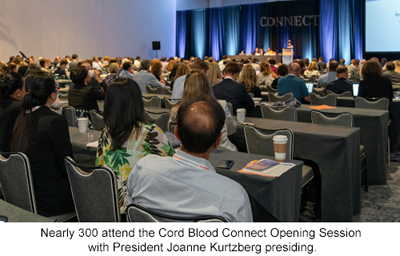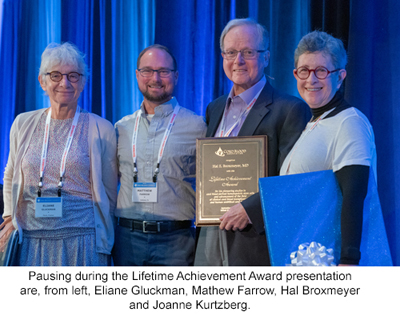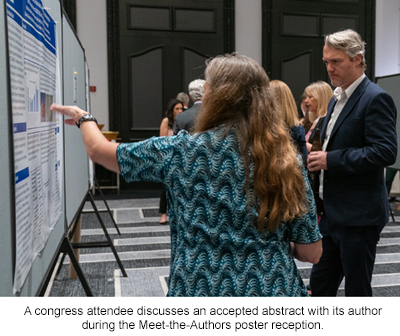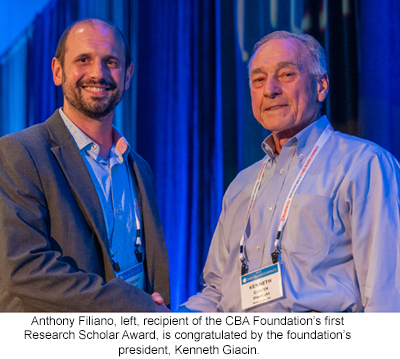'Cord Blood Connect' Exceeds High Expectations
Free online access available for 48 speaker presentations
Add them up: 350 registered participants from 29 countries, 57 speaker presentations, 31 posters, 4 oral presentations of best abstracts, 19 exhibits, 1 spectacular oceanside venue. The total was a Cord Blood Connect that met or exceeded high expectations.
The international congress, held Sept. 13-15 in Miami Beach, focused on the future of cord blood and birthing tissue therapies and their potential and novel applications for transplantation and regenerative medicine. Authorities from throughout the world addressed both the scientific and technical aspects of banking and therapies including advances in regenerative medicine, cellular manufacturing, quality assurance, optimal cord blood donor selection, novel clinical trial design, regulatory challenges, clinical applications and much more. The congress abstracts are published as a supplement to STEM CELLS Translational Medicine and also can be accessed online. Open-Access Videos Video recordings of 48 speaker presentations are now online and can be accessed free of charge. The CBA Board of Directors allocated funds for the on-demand streaming of more than 22 hours of scientific and technical information, consistent with the association’s mission to advance cord blood and cord tissue therapies and banking. The video presentations can be helpful to those who were unable to attend the congress, as well as attendees who want to review a presentation that they saw or a concurrent session that they missed. Lifetime Achievement Among the highlights of the congress was a keynote presentation by Dr. Hal Broxmeyer on enhancing the efficacy of cord blood hematopoietic cell transplantation. Dr. Broxmeyer was presented this year’s CBA Lifetime Achievement Award.
Internationally recognized for his pioneering studies of human umbilical cord blood as a source of transplantable hematopoietic stem cells, Dr. Broxmeyer has been instrumental in establishing the field of clinical cord blood transplantation. In the early- to mid-1980s, he and his team at Indiana University were the first to suggest that umbilical cord blood could serve as a source of hematopoietic stem cells for transplant. He coordinated a team of scientists and clinicians to collect and bank cord blood from siblings of patients with life-threatening blood disorders treatable with transplantation. This led, in October 1988, to the successful transplantation of a five-year-old boy with Fanconi anemia, a rare and serious inherited blood disorder that leads to bone marrow failure. The donor was his healthy, HLA-matched baby sister. Cord blood transplants have since been performed more than 35,000 times to treat diseases such as leukemia, lymphoma, sickle cell disease and Wiskott-Aldrich syndrome. An entire industry of cord blood banking has sprung up, and there are promising studies for treatments for many other diseases in the future. ‘Thank You Hal’ Joining in the presentation of the Lifetime Achievement Award were Eliane Gluckman, MD, who performed the first successful umbilical cord blood transplant on a human in 1988 in Paris; Mathew Farrow who, at age 5, was Dr. Gluckman's patient for that first cord blood transplant; and Joanne Kurtzberg, MD, Mathew’s referring pediatric physician and current president of the Cord Blood Association. Dr. Broxmeyer was presented with a “Thank You Hal” book with photos and notes from a few of the thousands of patients who have benefited from his work. Each two-page spread in the book has a message from a patient, or patient’s family, most of them handwritten, photos of the patient at the time of the transplant and today, and the patient’s “transplant birthday” indicating when the transplant was performed. Many of the transplant recipients were infants or children and are adults today.
Another highlight was the President’s Session which addressed important issues in regulations, ethical research and clinical trials. Peter Marks, MD, PhD, director of the FDA Center for Biologics Evaluation and Research, explained his agency’s approach to regulation of products derived from cord blood. The same session helped answer questions about who owns stored cord blood units and cord tissue, and who has the right to decide how they are used. The scientific sessions, develop by a program committee chaired by Colleen Delaney, MD, MSc, included optimizing donor selection and choice of conditioning regimens for post-transplant care, clinical trials involving cord-blood derived MSC therapies, cord blood transplant for non-malignant diseases, cord blood-derived cellular immunotherapies, clinical trials using cord blood-derived cell therapies for indications outside of transplant, and clinical trial design. The technical sessions, organized by a program committee chaired by Karen Ballen, MD, included cord blood bank financial health and sustainability, quality assurance, achieving a high-quality cord blood inventory, optimizing interactions with potential industry partners, and what can be learned from international regulatory agencies and registries. Anthony Filiano, PhD, assistant professor at the Marcus Center for Cellular Cures at Duke University, received the Cord Blood Association Foundation’s first Research Scholar Award. Financial assistance will be provided for his study of how cells derived from umbilical cord tissue can reprogram immunity and suppress inflammation. The Research Scholar Award was presented by Kenneth Giacin, MS, MBA, president of the CBA’s subsidiary foundation. The $25,000 competitive award, renewable for a second year, encourages young investigators who are pursuing laboratory and clinical studies that advance cord blood and perinatal tissue therapies or regenerative medicine. 2020 Congress CBA leaders announced that next year's Cord Blood Connect will return to Loews Miami Beach Hotel on Sept. 10-12, with pre-conference programs and workshops on Sept. 9. Early registration will open in February. |



 Ethics and Regulations
Ethics and Regulations Foundation Award
Foundation Award